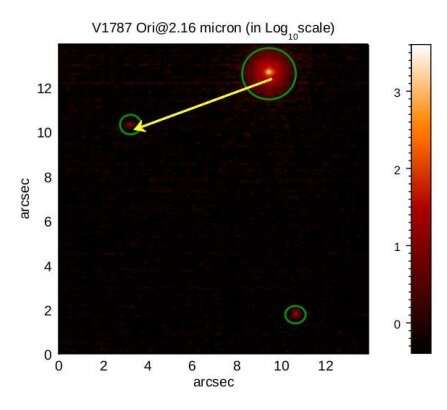November 30, 2020 report
Indian astronomers detect companion star to V1787 Ori

Astronomers from India have reported the finding of a companion star to an intermediate-mass Herbig Ae star known as V1787 Ori. The newly detected object turns out to be of M-type and is about 60% less massive than our sun. The discovery was detailed in a paper published November 20 on arXiv pre-print repository.
Located some 1,260 light years away, in the L1641 star-forming region of the Orion A molecular cloud, V1787 Ori (also known as Parenago 2649) is a young (less than 10 million years old) pre-main sequence (PMS) star of spectral type A5. Therefore, based on previous studies, the object has been classified as a Herbig Ae star. The mass of V1787 Ori is estimated to be around 1.66 solar masses.
Some observations of V1787 Ori have suggested that one of the stars in its vicinity may be associated with this object. A new study recently published by researchers led by Roy Arun of Christ (deemed to be a university) in Bangalore, India, confirms this assumption. By analyzing photometric data from various astronomical surveys (including 2MASS, SDSS, Pan-STARRS) they identified a companion star to this object.
"In this study, we report the detection of a wide binary companion, V1787 Ori B, to the HAeBe star V1787 Ori A," the astronomers wrote in the paper.
V1787 Ori B is separated by 2,577 AU from V1787 Ori A and appears to have spectral type M5. The astronomers estimate that V1787 Ori B is about 8.1 million years old, what is consistent with the age V1787 Ori A—calculated to be some 7.5 million years. Both stars have similar proper motions and distances within the uncertainties. According to the paper, the results confirm that the two objects form a PMS binary system.
The study confirmed that the two stars are members of the L1641 star-forming region. The mass of V1787 Ori B was measured to be about 0.39 solar masses, therefore the mass ratio of the system is approximately 0.23. Such a low mass ratio is rarely found among the known Herbig Ae/Be binary systems.
"The mass ratio is found to be 0.23, identifying this system as a rare one among HAeBe binaries. However, since this kind of mass ratio is seen among A-type binaries in the field and star forming regions, it is quite possible that there may be more low q binaries among PMS binaries such as the V1787 Ori system," the astronomers explained.
Trying to find the most plausible hypothesis explaining the formation of the V1787 Ori system, the authors of the paper point out to prestellar core collapse and filament fragmentation. However, further multiwavelength observations of this system are required to confirm any of the suggested scenarios.
More information: Discovery of an M-type Companion to the Herbig Ae Star V1787 Ori, arXiv:2011.10222 [astro-ph.SR] arxiv.org/abs/2011.10222
© 2020 Science X Network





















